From deep-sea pipelines to towering aircraft, high-quality welds are the backbone of critical infrastructure. In industries like oil & gas, shipbuilding, and aerospace, even the smallest weld defect can lead to massive failures. That’s why more engineers and fabricators are turning to welding cameras and weld monitoring systems to ensure precision, safety, and efficiency on every project.In this article, we explore how welding cameras are transforming real-world welding applications across three of the world’s most demanding industries.
Why Welding Cameras Are Essential in Critical Industries
Traditional welding inspection techniques rely heavily on post-weld evaluation. But in high-risk sectors, that’s often too late. A camera for welding provides real-time arc welding images, allowing operators and inspectors to monitor weld formation as it happens—minimizing rework, preventing weld defects, and ensuring higher-quality outcomes.
Let’s break down the benefits and applications industry by industry.
1. Oil & Gas: Enhancing Weld Quality in Harsh Environments
The oil and gas sector involves metal arc welding, MIG and MAG welding processes, and TIG welding for pipelines, pressure vessels, and offshore platforms. These welds must withstand extreme temperatures, pressure, and corrosion.
Applications:
- Pipeline Welding – Long, continuous welds across vast distances require consistent quality. Welding cameras help detect root pass flaws like porosity and slag inclusion in real-time.
- Offshore Welding – Remote-controlled robotic welding on subsea structures is often monitored using welding visual inspection tools with camera feeds.
- Refinery Maintenance – In tight, high-risk areas, cameras reduce the need for manual inspection, improving safety and reducing downtime.
Benefits:
- Early detection of internal defects
- Heat input monitoring for better joint integrity
- Reduced risk of failure and costly repairs
2. Shipbuilding: Navigating Complexity with Precision
Shipbuilding requires large-scale welds across hulls, decks, and internal systems using MIG welding, TIG, and plasma arc welding. The massive size of the workpieces and variety of materials make consistency a major challenge.
Applications:
- Hull Fabrication – Weld monitoring systems are used to maintain straight seams and prevent distortion during long welding runs.
- Compartment Assembly – Cameras track welding quality in tight or hidden areas where direct inspection is difficult.
- Propeller & Engine Room Construction – High-precision joints are monitored for gas coverage, weld penetration, and structural soundness.
Benefits:
- Reduced rework and faster defect identification
- Real-time alignment checks in automated and manual welding
- Documentation for quality assurance and compliance
3. Aerospace: Meeting Stringent Standards with Cutting-Edge Tech
In aerospace, weld integrity directly impacts passenger safety and flight performance. Welding processes like TIG welding (Tungsten Inert Gas), laser welding, and plasma arc welding are used for lightweight alloys and critical components.
Applications:
- Airframe Manufacturing – Welding cameras help manage heat input and bead size on thin, lightweight metals.
- Engine Parts Welding – Real-time monitoring prevents weld problems such as cracks or porosity in high-performance materials.
- Satellite and Rocket Fabrication – Precision welds on exotic materials like titanium are monitored closely using infrared and high-resolution welding camera systems.
Benefits:
- Extreme accuracy with minimal thermal distortion
- Live inspection and correction during automated welding
- Compliant with aerospace welding regulations and traceability standards
Why More Industries Are Choosing Welding Cameras
Across all three industries, the shift toward real-time welding technology is driven by:
- Improved Weld Quality – Reduced defects and stronger joints
- Process Optimization – Enhanced control over heat, speed, and angles
- Real-Time Inspection – Visualize and correct issues as they happen
- Cost Efficiency – Less rework, material waste, and downtime
- Safety and Compliance – Better documentation and traceability
Conclusion: Real-World Applications of Welding Cameras
Whether it’s an underwater pipeline, an aircraft fuselage, or the hull of a commercial vessel, one thing remains constant: quality welds are non-negotiable. Weld monitoring cameras offer a smarter, safer, and more efficient way to meet that demand.
By integrating high-performance welding cameras from a trusted welding camera manufacturer, teams can eliminate guesswork, reduce weld defects, and maintain top-tier welding quality in even the most complex environments.
Mecaweld provides advanced weld monitoring systems tailored for high-demand applications in oil & gas, shipbuilding, and aerospace. Contact us today to see how our solutions can elevate your welding precision and performance.



